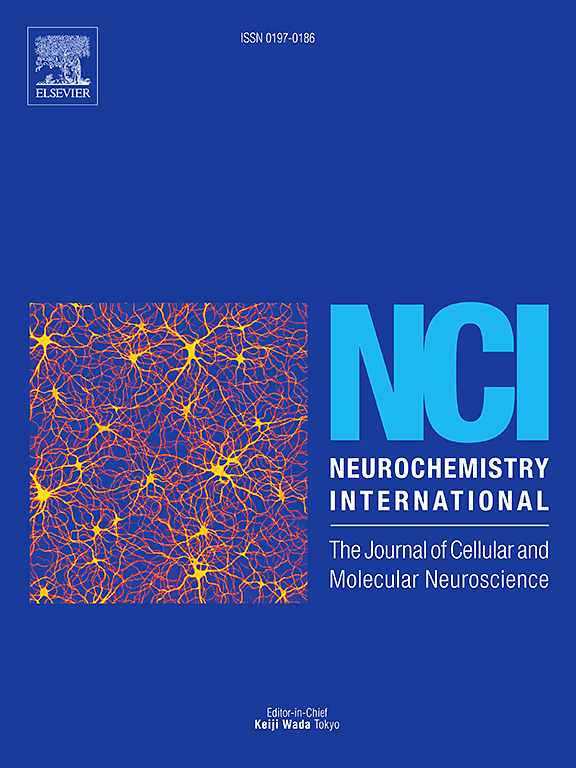Intermittent theta burst stimulation is superior to 10 Hz-repetitive transcranial magnetic stimulation in promoting episodic-like memory in healthy male rats by enhancing low γ oscillation and glutamate neuronal activities of the anterior cingulate cortex
IF 4
3区 医学
Q2 BIOCHEMISTRY & MOLECULAR BIOLOGY
引用次数: 0
Abstract
Intermittent theta-burst stimulation (iTBS) and high-frequency repetitive transcranial magnetic stimulation (rTMS) produce beneficial after-effects on memory performance. The two modalities have modulatory after-effects on the prefrontal neuronal oscillations and neurotransmitters, which are critically involved in episodic memory processing. However, whether iTBS exerts better cognitive effects than high-frequency rTMS through modulating neuronal oscillations and neurotransmitter levels in the prefrontal cortex has not been determined. Thus, iTBS and 10 Hz-rTMS modalities were applied to healthy male rats respectively, and behavior tests, electrophysiological experiments and microdialysis and neurochemistry were performed. We found that iTBS and 10 Hz-rTMS promoted episodic memory in healthy male rats, and iTBS exerted better cognitive effects than 10 Hz-rTMS. Intriguingly, iTBS induced greater effects than 10 Hz-rTMS in enhancing low γ oscillation in the anterior cingulate cortex (ACC) which is a subregion of the prefrontal cortex. Further, compared to sham stimuli, iTBS suppressed δ oscillation and enhanced θ oscillation, while 10 Hz-rTMS did not, suggesting that iTBS induces higher cortical excitability in the ACC than 10 Hz-rTMS. This is supported by a higher increase in glutamate neuronal activities in the ACC following iTBS than 10 Hz-rTMS. Finally, we found that iTBS and 10 Hz-rTMS decreased extracellular gamma-aminobutyric acid levels and increased extracellular glutamate levels in the ACC, thus leading to the activation of ACC glutamate neurons after the two modalities. These findings suggest that iTBS produces better cognitive effects in healthy male rats, which may be attributed to enhanced low γ oscillation and activated glutamatergic neurons in the ACC.
间歇性θ波爆发刺激通过增强前扣带皮层的低γ振荡和谷氨酸神经元活动,在促进健康雄性大鼠情景样记忆方面优于10hz重复经颅磁刺激。
间歇脉冲刺激(iTBS)和高频重复经颅磁刺激(rTMS)对记忆性能产生有益的后效。这两种模式对前额叶神经元振荡和神经递质具有调节后效,而这些神经递质与情景记忆加工有关。然而,iTBS是否通过调节前额叶皮层的神经元振荡和神经递质水平而比高频rTMS发挥更好的认知效果尚未确定。为此,分别采用iTBS和10hz - rtms模式对健康雄性大鼠进行行为测试、电生理实验、微透析和神经化学实验。我们发现iTBS和10hz - rtms对健康雄性大鼠的情景记忆有促进作用,且iTBS的认知效果优于10hz - rtms。有趣的是,iTBS在增强前扣带皮层(ACC)的低γ振荡方面比10hz - rtms有更大的作用。此外,与假刺激相比,iTBS抑制了δ振荡,增强了θ振荡,而10hz - rtms则没有,这表明iTBS比10hz - rtms诱导的ACC皮层兴奋性更高。iTBS后ACC中谷氨酸神经元活动的增加高于10hz - rtms。最后,我们发现iTBS和10hz - rtms降低ACC细胞外γ -氨基丁酸水平,增加ACC细胞外谷氨酸水平,从而导致两种模式后ACC谷氨酸神经元的激活。这些发现表明,iTBS在健康雄性大鼠中产生更好的认知效果,这可能归因于ACC中低γ振荡增强和激活的谷氨酸能神经元。
本文章由计算机程序翻译,如有差异,请以英文原文为准。
求助全文
约1分钟内获得全文
求助全文
来源期刊

Neurochemistry international
医学-神经科学
CiteScore
8.40
自引率
2.40%
发文量
128
审稿时长
37 days
期刊介绍:
Neurochemistry International is devoted to the rapid publication of outstanding original articles and timely reviews in neurochemistry. Manuscripts on a broad range of topics will be considered, including molecular and cellular neurochemistry, neuropharmacology and genetic aspects of CNS function, neuroimmunology, metabolism as well as the neurochemistry of neurological and psychiatric disorders of the CNS.
 求助内容:
求助内容: 应助结果提醒方式:
应助结果提醒方式:


